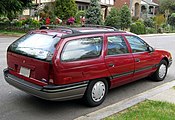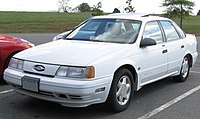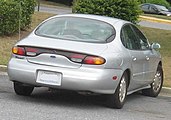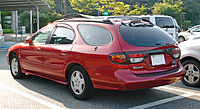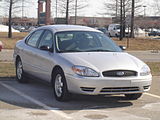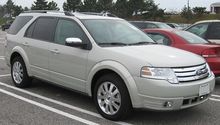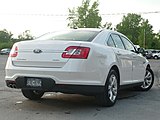Ford Taurus
| Ford Taurus | |
|---|---|
| Production period: | since 1986 |
| Class : | upper middle class |
| Body versions : | Limousine , station wagon |
| Previous model: | Ford LTD |
The Ford Taurus is a car model made by the US automobile company Ford .
According to US standards, the Taurus can be classified as a middle class model. Since 1986 it has been produced in seven series. The Ford Taurus is available as a sedan, until 2007 it was also offered in a station wagon version. The sport version is called the Taurus SHO . The largely structurally identical model of the Ford Group brand Mercury is called Sable . The Ford Taurus is the standard middle and senior service vehicle of many US agencies, such as the FBI .
The Ford Taurus has been a full-size car since the fifth generation .
Taurus (1986-1991)
| 1st generation | |
|---|---|
|
Ford Taurus Sedan (1986-1989) |
|
| Production period: | 1986-1991 |
| Body versions : | Limousine , station wagon |
| Engines: |
Petrol engines : 2.5-3.8 liters (65-164 kW) |
| Length: | 4785-4874 mm |
| Width: | 1796 mm |
| Height: | 1382-1402 mm |
| Wheelbase : | 2690 mm |
| Empty weight : | 1245-1569 kg |
The Taurus was a big step forward both stylistically and technically. It was Ford's first American mid- size front-wheel drive car .
In the spring of 1986 Ford introduced the front-wheel drive Taurus (as a four-door sedan and as a five-door station wagon) as the successor to the Ford LTD with rear-wheel drive. The body was modern, with flush headlights and without a traditional radiator grille designed to be aerodynamic. The equipment levels included the basic model L, the petrol-saving model MT5, as well as GL and LX. The engines were a 2.5-liter in-line four-cylinder with 65 kW (89 hp) or a three-liter V6 with 104 kW (142 hp), the latter as standard in the LX. The MT5 was only available with a five-speed gearbox, the other four-cylinder models were delivered with a three-speed automatic transmission, the V6 engine with a four-speed automatic transmission.
From 1987 the four-cylinder developed 67 kW (91 PS), otherwise the successfully launched Taurus remained unchanged this year.
From 1988 the MT5 station wagon was discontinued and a new 3.8-liter V6 engine was available for all models (except MT5) at an additional cost. With 104 kW it performed just as much as the three-liter still offered, but had a higher maximum torque.
The MT5 sedan also dropped out of the range in 1989. What was new, however, was the Taurus SHO as a sports sedan with a 164 kW (223 hp) three-liter V6 with 24 valves and two overhead camshafts , a five-speed gearbox, sports suspension and sporty equipment , developed by Ford together with Yamaha and also built there .
For the 1990 model year, all models received a revised interior with an airbag steering wheel and a new dashboard in the late summer of 1989.
From the end of 1990, thanks to sequential injection, the four-cylinder now had 78 kW (106 hp) and also received the four-speed automatic transmission. The SHO was now available with 16-inch alloy wheels.
Ford produced 1.96 million copies of the first generation Taurus in just under six years.
Taurus (1991-1995)
| 2nd generation | |
|---|---|
|
Ford Taurus Sedan (1991-1995) |
|
| Production period: | 1991-1995 |
| Body versions : | Limousine , station wagon |
| Engines: |
Gasoline engines : 3.0-3.8 liters (104-164 kW) |
| Length: | 4877-4905 mm |
| Width: | 1808 mm |
| Height: | 1374-1410 mm |
| Wheelbase : | |
| Empty weight : | 1409-1538 kg |
The revised version of the Taurus was built from autumn 1991 to summer 1995. Its body looked very similar to that of the first series, but was completely redesigned and the interior was also redesigned.
The new Taurus was again available in the L, GL and LX versions from autumn 1991, each as a four-door and station wagon, and as a SHO sports sedan . The four-cylinder was omitted, the three-liter V6 and the also 104 kW (141 hp) 3.8-liter V6 engine were available, both coupled with a four-speed automatic transmission; In the SHO the Ford / Yamaha three-liter did its job unchanged.
In autumn 1992 the entry-level model L was canceled and the SHO was also available with automatic for the first time; In the automatic SHO, a 3.2 liter version of the Ford / Yamaha V6 engine with a higher torque was used.
In mid-1993, the standard equipment on all models was expanded to include a passenger airbag.
In the fall of 1994, the SE sedan, located between GL and LX, was added to the range. The equipment of the GL has been expanded to include a heated rear window, tinted windows and air conditioning.
The second generation Taurus was the best-selling car on the US market in the calendar years from 1992 to 1995. In total, Ford produced around 1.5 million copies.
Taurus (1995-1999)
| 3rd generation | |
|---|---|
|
Ford Taurus Sedan (1995-1998) |
|
| Production period: | 1995-1999 |
| Body versions : | Limousine , station wagon |
| Engines: |
Petrol engines : 3.0-3.4 liters (108-179 kW) |
| Length: | 5017 mm |
| Width: | 1854 mm |
| Height: | 1400 mm |
| Wheelbase : | |
| Empty weight : | 1492-1605 kg |
From late summer 1995 to the end of 1999 the Taurus was built in a completely new design. However, this series was no longer as successful as its predecessor, because many buyers found their style too radical. The shape turned out to be very round and flat, especially the oval-shaped rear windows were controversial.
The new Taurus was launched in September 1995, again as a four-door sedan and five-door station wagon in the GL and LX equipment variants, plus the SHO sports sedan. The GL had a 108 kW (147 PS) three-liter V6, the LX a 149 kW (203 PS) three-liter V6 with two overhead camshafts and the SHO a 3.4-liter V8 with 179 kW (243 PS) . The SHO was only offered with four-stage automatic.
In the spring of 1997, the G was added to the Taurus range as an entry-level model. The SHO received new five-spoke alloy wheels and a rear spoiler in body color.
At the beginning of 1998 the model range was reorganized; the LX was now available as a sedan, the more extensively equipped SE as a sedan and station wagon and the SHO as a sports sedan. The LX and SE had the 108 kW three-liter as standard, but both could also be ordered with the 149 kW variant. The grille and front apron were given a slight facelift.
From the beginning of 1999, the 149 kW V6 was no longer available for the LX.
The third generation Taurus could no longer defend the top position that its predecessor had in the US sales statistics. Despite everything, Ford was able to sell around 1.4 million units in four years.
Cultural reference
"Now Ronnie drives a new Taurus, silvery gray like a Teflon pan, in 1999 styling, in which every detail is teardrop-shaped oval - the taillights, the headlights, the recessed door handles, all the same shape, and the rear, where you can see the trunk unfolds, a long, squeezed cross oval, like a mustache or a rolling pin made from ready-made baking mixture, which is compressed in the middle. "
Taurus (1999-2006)
| 4th generation | |
|---|---|
|
Ford Taurus Sedan (1999-2003) |
|
| Production period: | 1999-2006 |
| Body versions : | Limousine , station wagon |
| Engines: |
Petrol engines : 3.0 liters (115–149 kW) |
| Length: | 5017 mm |
| Width: | 1854 mm |
| Height: | 1400 mm |
| Wheelbase : | |
| Empty weight : | 1492-1605 kg |
In response to the criticism of the design of the previous model, the Ford Taurus received a comprehensive facelift in November 1999, which made the look of the car much more conventional.
From the end of 1999 to the end of 2006, the revised Taurus in the versions LX, SE, SES and SEL was sold as a four-door sedan and a five-door station wagon. The SHO was no longer available with the model change. It was powered by the now 115 kW (157 hp) three-liter V6 or (until 2005) by the 149 kW DOHC three-liter with four-speed automatic.
A slight facelift followed in autumn 2003, which could be recognized by the modified front and rear aprons. From the beginning of 2005 the Taurus was only available to fleet customers.
The Ford Five Hundred presented in mid-2004 was designed as the successor to the Taurus. However, there was heavy criticism of the renaming, and the Five Hundred was not accepted by potential buyers as a worthy successor to the Taurus. Ford management was accused of ignorance about a twenty-year successful model range. The criticism did not remain without effect on the management, which was already unsettled by various failures; From the 2008 model year the name Taurus was used again for the thoroughly revised Five Hundred.
Taurus (2007-2009)
| 5th generation | |
|---|---|
|
Ford Taurus Sedan (2007-2009) |
|
| Production period: | 2007-2009 |
| Body versions : | limousine |
| Engines: |
Otto engine : 3.5 liters (194 kW) |
| Length: | 5125 mm |
| Width: | 1892 mm |
| Height: | 1562 mm |
| Wheelbase : | 2868 mm |
| Empty weight : | |
The Ford Five Hundred , built since 2004, received a fundamental facelift for the 2008 model year in summer 2007 and was now offered again under the name Taurus (the sister model Montego now as Sable ). As with the Five Hundred, there was no longer a station wagon version , but an SUV version called the Taurus X , with the Five Hundred this was the Ford Freestyle .
The most important changes compared to the Five Hundred were modifications to the design with a three-lined grille similar to that of the Ford Fusion , changed front and rear lights and a new 3.5-liter engine with 194 kW (264 hp), also from the Ford Edge and replaced the previous three-liter V6 with 149 kW (203 hp). Instead of the previous CVT transmission , a conventional six-speed automatic was used.
Taurus (2009-2019)
| 6th generation | |
|---|---|
|
Ford Taurus Sedan (2009-2012) |
|
| Production period: | 2009-2019 |
| Body versions : | limousine |
| Engines: |
Gasoline engine : 3.5 liters (196-272 kW) |
| Length: | 5153 mm |
| Width: | 1935 mm |
| Height: | 1542 mm |
| Wheelbase : | 2868 mm |
| Empty weight : | 1777-1963 kg |
The sixth generation of the Taurus was launched on the US market in mid-2009.
This model is available in three equipment lines. There are two 3.5-liter engines with 196 kW (267 hp) and 272 kW (370 hp) on offer. Production of the Taurus X was discontinued with the model change in summer 2009 and the Ford Flex has been built as a successor since 2008 .
After the production of the Ford Crown Victoria was also ended in August 2011, the Taurus has since been the top model in the Ford Group's sedan segment. A government version is offered as the Police Interceptor Sedan as the successor to the Crown Victoria Police Interceptor .
Facelift
For the 2013 model year, the Taurus received a facelift in autumn 2012. In addition to a modified radiator grille, the output of the 3.5-liter engine has also been increased to 212 kW.
Engines
| model | 3.5 V6 Duratec | 3.5 V6 Ecoboost | 3.5 V6 Ecoboost |
|---|---|---|---|
| Displacement (cm³) | 3496 | 3496 | 3496 |
| Max. Power (kW / PS) | 196/267 at 6250 | 212/288 at 6500 | 268/365 at 5500 |
| Max. Torque (Nm) | 338 at 4500 | 343 at 4000 | 475 at 3500 |
| Top speed (km / h) | |||
| Acceleration (0–97 km / h [s]) | 5.2 | ||
| Gearbox (standard) | 6-stage automatic | 6-stage automatic | 6-stage automatic |
| Carbon dioxide emissions [g / km] | 251 | ||
| Tank capacity [l] | 72 | 72 | 72 |
Awards
- 2009: Top Safety Pick 2010
Taurus (China)
| 7th generation | |
|---|---|
|
Ford Taurus (since 2016) |
|
| Production period: | since 2016 |
| Body versions : | limousine |
| Engines: |
Petrol engines : 1.5–2.7 liters (133–242 kW) |
| Length: | 4996-5018 mm |
| Width: | 1878-1884 mm |
| Height: | 1503-1506 mm |
| Wheelbase : | 2949 mm |
| Empty weight : | 1707-1875 kg |
| Stars in the C-NCAP - Crash Test (2016) |
|
The seventh generation of the Taurus was presented to the public at the Shanghai Auto Show in April 2015 . The vehicle is built in Hangzhou , China . The seventh generation has been sold exclusively in China since January 2016, while the previous model is still being sold in other markets such as the USA (as of September 27, 2017). In 2018, Ford announced that the Taurus range would be discontinued in the United States, as would the Focus sedan. Ford wants the model range in the USA to consist of 90% SUVs in the future. The reason for the discontinuation of both sedans is the lack of profitability due to low demand.
Technical specifications
| Parameters | EcoBoost 180 | EcoBoost 245 | EcoBoost 325 V6 | |
|---|---|---|---|---|
| Construction period | 01/2016–08/2019 | since 08/2019 | 01/2016–03/2018 | |
| Engine characteristics | ||||
| Engine type | R4 petrol engine | V6 petrol engine | ||
| Displacement | 1499 cc | 1999 cc | 2694 cc | |
| Compression ratio | 10: 1 | 9.7: 1 | 10: 1 | |
| Max. power | 133 kW (181 hp) at 6000 rpm |
180 kW (245 PS) at 5500 rpm |
242 kW (329 hp) at 5500 rpm |
|
| Max. Torque | 240 Nm at 1750-4500 rpm |
350 Nm at 1750-4000 rpm |
390 Nm at 2500-3500 rpm |
475 Nm at 2500-4500 rpm |
| Power transmission | ||||
| Drive, as standard | Front wheel drive | |||
| Gearbox, as standard | 6- speed automatic transmission | 8-speed automatic transmission | 6-speed automatic transmission | |
| Readings | ||||
| Top speed | 208 km / h | 218 km / h | 228 km / h | 234 km / h |
|
Acceleration, 0-100 km / h |
10.6 s | 7.9 s | 8.5 s | 6.9 s |
|
Fuel consumption over 100 km (combined) |
7.1 l super | 8.3 l super | 7.2–7.5 l super | 9.2 l super |
| Empty weight | 1707 kg | 1745-1794 kg | 1746-1803 kg | 1875 kg |
| Tank capacity | 64 l | |||
Individual evidence
- ↑ © 2018 JimHayesinc.com: 2016 Ford Taurus Technical Specifications. Retrieved December 14, 2018 .
- ↑ Homepage
- ↑ http://www.autobild.de/artikel/die-sicherheitsten-us-autos-2010_1012142.html
- ↑ Safety impact test result. In: c-ncap.org. Retrieved January 13, 2019 (Chinese).
- ↑ Shanghai LIVE: 2016 Ford Taurus. April 21, 2015, accessed October 20, 2016 .
- ^ Ford Taurus launched on the Chinese car market. January 15, 2016, accessed October 20, 2016 .


